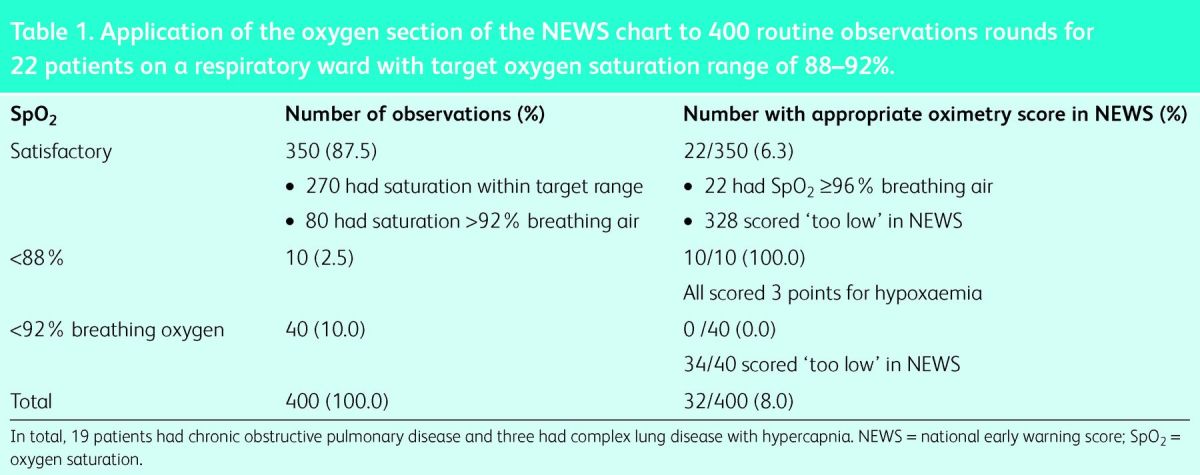The national early warning score gives misleading scores for oxygen saturation in patients at risk of hypercapnia
A national early warning score (NEWS) system has been introduced in the UK to identify and protect patients at risk of serious clinical deterioration.1–3 The system allocates EWS points when oxygen saturation (SpO2) is below 96%. Although we strongly support the principles of NEWS, we have previously expressed concern that the SpO2 score is not appropriate for patients with risk factors for hypercapnic respiratory failure.4 These patients account for up to 10% of non-elective hospital admissions and up to half of patients requiring oxygen therapy in UK hospitals. The recommended oxygen target range to minimise morbidity and mortality for these vulnerable patients is 88–92% or sometimes less.5,6 NEWS does not accommodate this high-risk and vulnerable group. To safeguard this group of patients, we have developed a modified NEWS system called Salford NEWS. This modified system allocates EWS points if patients are below or above their optimal target range and documents oxygen usage more clearly than the NEWS chart. We have piloted the Salford NEWS chart successfully on two medical wards and it will be introduced hospital wide during 2014.
To quantify the impact of the NEWS system on patients at risk of hypercapnic respiratory failure, we applied the oxygen section of the NEWS chart to 400 routine observation rounds for 22 patients on a respiratory ward with a target SpO2 range of 88–92% (19 patients had chronic obstructive pulmonary disease and three had complex lung disease with hypercapnia). The results are shown in Table 1.
Table 1.
Application of the oxygen section of the NEWS chart to 400 routine observations rounds for 22 patients on a respiratory ward with target oxygen saturation range of 88–92%.

Using the NEWS system, 92% of observations gave an inappropriate score for SpO2. In addition, 328 of 350 satisfactory oximetry readings (within the safe target range of 88–92% or above this range breathing air) were scored by NEWS as hypoxaemic where SpO2 was below 96%. The median EWS was 5 using the NEWS system and 2 using Salford NEWS. Scores of 5 and above require medical review. Using the unmodified NEWS chart, review would be required for 56% of at-risk patients during every observation round compared with 18% of patients using the Salford NEWS chart. The majority of extra reviews would be generated by SpO2 values that were appropriate for the patient. Furthermore, the NEWS system failed to identify the 40 instances where SpO2 was above the target range due to excessive oxygen therapy. An inappropriate score for hypoxaemia was given in 34 of these cases. Inappropriate NEWS scores could cause inexperienced nurses or doctors to give additional oxygen to patients whose SpO2 is within or above the safe target range of 88–92%. This is a major concern because of the association of excessive oxygen administration with increased morbidity and mortality in patients at risk of hypercapnic respiratory failure.5,6
We believe that bedside documents and electronic observation charts should facilitate improved practice. We are working with colleagues at the Royal College of Physicians and the British Thoracic Society to modify the NEWS chart to enhance the safety of patients with risk factors for hypercapnic respiratory failure who account for up to half of oxygen use in UK hospitals.
References
- 1.Subbe CP, Davies RG, Williams E, Rutherford P, Gemmell L. Effect of introducing the modified early warning score on clinical outcomes, cardio-pulmonary arrests and intensive care utilisation in acute medical admissions. Anaesthesia 2003;58:797–802. 10.1046/j.1365-2044.2003.03258.x [DOI] [PubMed] [Google Scholar]
- 2.Royal College of Physicians National Early Warning Score (NEWS). Available online at www.rcplondon.ac.uk/resources/national-early-warning-score-news [Accessed September 2013]. [Google Scholar]
- 3.Jones M. NEWSDIG: The National Early Warning Score Development and Implementation Group. Clin Med 2012;12:501–3. 10.7861/clinmedicine.12-6-501 [DOI] [PMC free article] [PubMed] [Google Scholar]
- 4.O’Driscoll BR, Bakerly ND, Murphy P, et al. Concerns regarding the design of the bedside monitoring chart for use with the NEWS (National Early Warning System). Clin Med 2013;13:319–20. 10.7861/clinmedicine.13-3-319 [DOI] [PMC free article] [PubMed] [Google Scholar]
- 5.O’Driscoll BR, Howard LS, Davison AG. BTS guideline for emergency oxygen use in adult patients. Thorax 2008;63(suppl 6):1–68. 10.1136/thx.2007.086215 [DOI] [PubMed] [Google Scholar]
- 6.Austin MA, Wills KE, Blizzard L, Walters EH, Wood-Baker R. Effect of high flow oxygen on mortality in chronic obstructive pulmonary disease patients in prehospital setting: randomised controlled trial. BMJ 2010;341:c5462. 10.1136/bmj.c5462 [DOI] [PMC free article] [PubMed] [Google Scholar]


